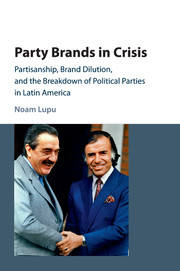 Party Brands in Crisis
Party Brands in Crisis Book contents
- Frontmatter
- Dedication
- Contents
- List of figures
- List of tables
- Acknowledgments
- 1 Why do parties break down?
- 2 Brand dilution and party breakdown
- 3 Explaining party breakdown across Latin America
- 4 Argentina: Peronism survives, Radicals collapse
- 5 Venezuela: AD and COPEI break down
- 6 Party brands and mass partisanship: experimental evidence
- 7 Party brands and mass partisanship in comparative perspective
- 8 Parties, partisanship, and democracy: conclusions
- Appendix
- Bibliography
- Index
1 - Why do parties break down?
Published online by Cambridge University Press: 18 December 2015
- Frontmatter
- Dedication
- Contents
- List of figures
- List of tables
- Acknowledgments
- 1 Why do parties break down?
- 2 Brand dilution and party breakdown
- 3 Explaining party breakdown across Latin America
- 4 Argentina: Peronism survives, Radicals collapse
- 5 Venezuela: AD and COPEI break down
- 6 Party brands and mass partisanship: experimental evidence
- 7 Party brands and mass partisanship in comparative perspective
- 8 Parties, partisanship, and democracy: conclusions
- Appendix
- Bibliography
- Index
Summary
Between 1958 and 1993, Venezuela's two major parties, Democratic Action (AD) and the Independent Political Electoral Organizing Committee (COPEI), together drew an average of 78 percent of the vote in national elections. But by 1998, a mere 3 percent of Venezuelans cast their ballots for these parties. After Bolivia transitioned to democracy in 1980, the three parties that dominated politics – the rightist Nationalist and Democratic Action (ADN), centrist Revolutionary Nationalist Movement (MNR), and center-left Revolutionary Left Movement (MIR) – together received an average of 67 percent of the vote. But in 2002, ADN attracted only 3 percent of the votes, and neither it nor the MIR even fielded a presidential candidate in the 2005 election.
The dramatic and sudden declines in the staying power of established political parties – parties with an extended history of being competitive for national office – is one of the most puzzling features of Latin American democratic politics since the ThirdWave of democratization. Between 1978 and 2007, onequarter of the region's established parties broke down, meaning that they suddenly became uncompetitive for national executive office. These breakdowns entailed an average drop of nearly 80 percent in the share of the party's vote from one election to the next. Parties that had only recently been major competitors were relegated to an average vote share of merely 6 percent. Yet these very parties, some more than a century old, had survived economic booms and busts, authoritarian repression, guerrilla insurgencies, and revolutionary movements.
Why, then, have many broken down in recent decades? Traditional theories of party politics fall flat in explaining party breakdown. Scholars of political parties expect party systems to form around enduring social cleavages or the political struggles that surround their emergence. Proponents of spatial models of party competition expect parties to consistently match voter preferences. Neither tradition can explain why established parties break down suddenly and decisively.
Scholars of comparative politics often attribute party breakdowns instead to poor performance by incumbent parties. Corruption scandals or poor economic stewardship, they argue, cause voters to reject the incumbent party en masse, leading the party to break down. But bad performance is far more widespread than party breakdown, and established parties have survived some major economic crises. In the 1980s in Peru, for instance, President Alan García's economic policies led to some of the worst hyperinflation in world history, peaking in 1989 at 12,378 percent.
- Type
- Chapter
- Information
- Party Brands in CrisisPartisanship, Brand Dilution, and the Breakdown of Political Parties in Latin America, pp. 1 - 15Publisher: Cambridge University PressPrint publication year: 2016
